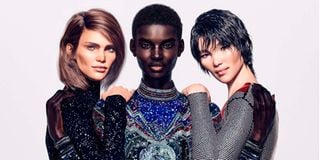Premium
Shudu, Zuri, Leo, Kycee , Stacy ... Digital models giving humans stiff competition

Digital models (from left) Margot, Shudu and Zhi.
Shudu is not your ordinary social media brand influencer. She is the world's first digital supermodel, with 215,000 followers on Instagram, attracting admiration from global celebrities like Alicia Keys, Tyra Banks and Naomi Campbell.
She may not be human to do a physical endorsement of your product, but the black celebrity wields enormous online power, with companies scrambling to get her to promote their goods.
Created by British fashion photographer Cameron-James Wilson three years ago, the emergence of Shudu, an entirely digital model, isn’t much of a surprise.
"Anyone can make a supermodel. I made Shudu from a very cheap gaming laptop in a shed in my mom's garden," says Wilson.
He has made six more virtual models, including Margot and Zhi, who starred alongside Shudu in Balmain’s 2018 campaign. Together, they make up The Diigitals - world’s first all-digital modelling agency.
For his latest creations, the 3D graphic designer is collaborating with his Instagram followers, who now influence how the physical countenance of the model will look like.
“Hopefully, they’ll feel some kind of emotional attachment because they'll have had a hand in creating them,” Wilson says.
Digital marketing
Though avatars are not a new idea in digital marketing, brands have been asking Wilson to create bespoke models for them.
“Our models have also now turned into personalities. Some have their own Instagram accounts, and Shudu now has her own voice.”
The fee rates for artificial models are lower than those of real-life models, but for digitally advanced brands, it can take three weeks to create an editorial avatar story compared to humans who take a maximum of one week.
But according to a consumer research conducted by Mindshare UK’s Futures division, almost 30 per cent of 18 to 34-year-olds surveyed said they would prefer a virtual fashion model who looked like them and had the same body shape over a real fashion model.
With the technology now available to turn human models into holograms, the world can expect to see virtual models strutting the catwalk as holograms in future.
“I don't even think it will be that far away at all,” says Wilson.
As technology advances, fashion and digital advertising have been fusing together well at a rapid rate, making artificial digital marketers more affordable and potentially threatening to take over advertising gigs from real humans.
For local celebrity Linet Munyali, popularly known as Size 8, while digital models help companies to make work easier, a balance is needed for a sustainable future ecosystem.
“We should not allow robots to run every aspect of our lives. I support the creatives behind them but we should not entirely trash human marketers just because we are obsessed with the future. We must strike a balance,” Linet, who has been promoting Softcare baby diapers on television told the Nation.
Artificial Intelligence
She adds that though the fascination of Artificial Intelligence (AI) running marketing and advertising could be a reality in the next 50 years, the Kenyan culture could take time to get used to inanimate online marketers as it is used to identifying with physical celebrities.
“Most brands in Kenya find attention when they use local celebrities that are well-known in the entertainment industry. The local mentality is not yet prepared for digital models,” she adds.
However, local social media influencers, she says, should start training themselves on how to use modern software to create incredible avatars tailored for various brands, otherwise online robots will take their jobs.
In Kenya, they come in the form of bots and avatars that answer your questions regarding various products and services offered by big corporates, but have been criticised for trying to eliminate the human appeal from customer care.
Egline Samoei, co-founder of Nairobi-based Brand Moran, a social media monitoring and consumer insight platform, says though bots reduce costs for banks and telcos, customers feel detached from the human aspect of real customer care agents.
“The emotional feel is totally lost because AI has struggled to create non-verbal cues on bots. You feel like you are talking to a lifeless being,” she told the Nation.
Some of the chatbots being utilised in the country are Safaricom’s Zuri, UBA’s Leo, KCB’s Kaycee, Co-operative Bank’s Mia and Standard Chartered’s Stacy.
Since Leo was launched in 2018, for instance, UBA has had over 100 million conversations with customers and carried out over 1.5 million financial transactions.
Online customer
But even with the upsurge in artificial customer experience being witnessed in Kenya, many loopholes still exist.
Real humans have gone ahead and impersonated Shudu and Zuri on Instagram and Facebook respectively, leading to an online loss of identity.
“Duplication is turning people away. Another point is that M-Pesa users do not feel secure when Zuri asks them for their PIN on Messenger or WhatsApp to solve hitches in their sim cards,” says Egline, who has been a digital marketer in the last six years.
However, she notes that bots could prove to be helpful for companies with a lean online customer care team. “Bots work round the clock without exhaustion. For humans, you will need to work in shifts.”
But artificial communication has been blamed for entrenching social discrimination, since most of them only have pre-programmed answers in English.
“They will not answer queries outside the English language, which is a big letdown for a Swahili and Sheng speaking language like Kenya. Bots are trained machines using data. We should see bots communicating in not only Swahili, but also local languages,” says Andrew Mukabana, a Nairobi-based data scientist.
Bots that understand braille are yet to be created for the fashion and marketing sectors, further derailing efforts to achieve universal digital inclusion.





